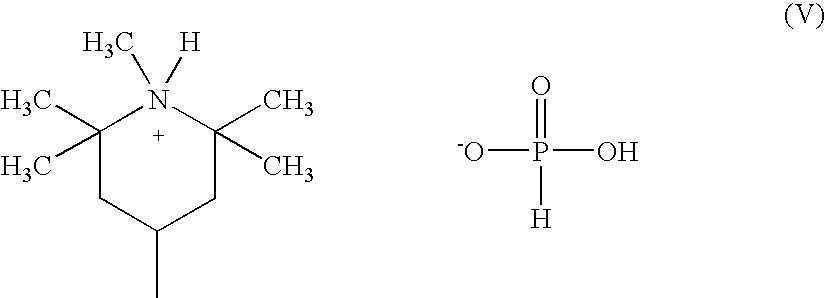Aluminum containing polyester polymers having low acetaldehyde generation rates
a technology of polyester polymer and acetaldehyde, which is applied in the field of polymer polymers, can solve the problems of unacceptably high aa levels in preforms, adversely affecting taste, and giving unacceptable levels of aa in preforms
- Summary
- Abstract
- Description
- Claims
- Application Information
AI Technical Summary
Benefits of technology
Problems solved by technology
Method used
Image
Examples
example 1
[0312] The Sb solution described in Comparative Example 1 are used here. For each type of catalyst system, catalyst level and temperature combination, the finisher time from the torque terminated run in Comparative Example 1 will be the finisher time (stage 12 time) used in this example. The same oligomer and procedure are used as described in the introduction to the Examples section. The lithium and aluminum solutions used are described in Comparative Example 1. The catalyst targets in Samples 159 & 166 were ˜23 ppm each Li & Al. The catalyst targets in Samples 161 &-154 were ˜46 ppm each Li & Al. The lithium to aluminum mole ratio (“Li:Al MR”) has a target of 4 for all the Li / Al runs in Table 2. The phosphorus target is 0 or 120 ppm.
[0313] For Li / Al runs in Table 2 with a phosphorus target of 120 ppm, an oligomeric phosphate triester with about 9 weight / weight percent phosphorus is added neat in Stage 14 of the following array. For Sb controls, 1.03 wt. / wt. % P solution of the sa...
example 2
[0324] The same array and oligomeric phosphate triester are used as described in Example 1. For each type of catalyst system, catalyst level and temperature combination, the finisher time from the torque termination run in Comparative Example 2 will be the finisher time used in this example. The same lithium and aluminum solutions are used as described in Comparative Example 2 and Comparative Example 1, respectively. The oligomer and procedure used are described in the introduction to the Examples section. The antimony solution used is described in Comparative Example 1.
[0325] The data are shown in Table 4. The lithium to aluminum mole ratio (“Li:Al MR”) has a target of 4 for all the Li / Al runs in Table 4. The catalyst targets are ˜11.5 ppm each Li & Al, ˜28.5 ppm each Li & Al or ˜45.5 ppm each Li & Al. The phosphorus target was 0, 120 or 240 ppm.
TABLE 4Temp.FinisherXRFICPICPLi:AlP:MP:Al(degTimeSbAlLiMoleICP PMoleMoleXRF PIhVItVSamplesC.)(min)(ppm)ppmppmRatio(ppm)RatioRatio(ppm)(...
example 3
[0332] Melt blending a preformed polymer with an additive in a glass flask achieves a uniform distribution of additive within the polymer like an extruder would—only with less shear and more time. A polymer is the starting material. It is catalyzed by 16 ppm Li and 21.5 ppm Al added right after esterification, is modified by 1.4 wt. % IPA and 1.7 wt. % DEG, and has an It. V. of 0.850 dL / g and an lh.V. of 0.804 dL / g. This polymer does not contain any catalyst deactivators or toners. The pellets are cryogenically ground to pass a 2 mm screen, and 100 grams of the polyester powder are weighed into a 500 mL round bottom flask. The powder is dried at 150° C. under full vacuum (25-30 in. Hg) overnight (about 16 hours) in a vacuum oven. After cooling the flask to room temperature in a desiccator, the catalyst-deactivating additive is weighed into the flask. The additive is 85% or 95% phosphoric acid (H3PO4). A polymer head with stirrer is attached and the flask purged twice with nitrogen. ...
PUM
| Property | Measurement | Unit |
|---|---|---|
| Temperature | aaaaa | aaaaa |
| Temperature | aaaaa | aaaaa |
| Temperature | aaaaa | aaaaa |
Abstract
Description
Claims
Application Information
 Login to View More
Login to View More - R&D
- Intellectual Property
- Life Sciences
- Materials
- Tech Scout
- Unparalleled Data Quality
- Higher Quality Content
- 60% Fewer Hallucinations
Browse by: Latest US Patents, China's latest patents, Technical Efficacy Thesaurus, Application Domain, Technology Topic, Popular Technical Reports.
© 2025 PatSnap. All rights reserved.Legal|Privacy policy|Modern Slavery Act Transparency Statement|Sitemap|About US| Contact US: help@patsnap.com



